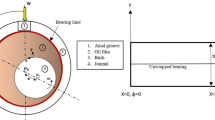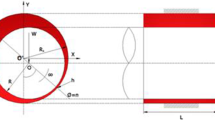Abstract
The objective of current research is to study the adiabatic solutions of a plain journal bearing operating with bio-based lubricants containing nanoparticles. Estimation of pressure and temperature fields has been accomplished by simultaneous numerical solutions of the modified Reynolds equation and the adiabatic energy equation. These equations have been solved by adopting the finite difference method with suitable iterative scheme. The analysis has been carried out taking into account the heating effects and non-Newtonian rheology of bio-based nanolubricant following the power law model. The results have been investigated for temperature and pressure fields and the static performance parameters for a broad range of eccentricity ratio ε and different power law index values. The calculated results present that the involvement of nanoparticles in bio-based lubricant significantly enhances the pressure, load carrying capacity and friction force. Moreover, the influence of thermal effects on performance parameters is seen to be maximum at higher values of power law index.

















Similar content being viewed by others
Abbreviations
- \(U\) :
-
Tangential velocity of the journal, m s−1
- \(\omega\) :
-
Angular velocity of the journal (\(\omega\) = U/R), rad s−1
- \(N\) :
-
Rotational speed, rpm
- h :
-
Film thickness, m
- e :
-
Eccentricity, m
- \(O_{\text{b}}\) :
-
Bearing centre
- \(O_{\text{J}}\) :
-
Journal centre
- \(h_{\min }\) :
-
Minimum fluid film thickness, m
- \(\mu\) :
-
Apparent viscosity, Pa s
- \(\mu_{0}\) :
-
Reference viscosity of the lubricant, Pa s
- \(\mu_{\text{nf}}\) :
-
Viscosity of nanolubricant, Pa s
- x, y, z :
-
Bearing coordinates, x measures along circumferential direction, y measures along the radial direction, z measures along the axial direction, m
- \(\theta\) :
-
Angular coordinate, rad
- R :
-
Journal radius, m
- D :
-
Journal diameter, m
- L :
-
Bearing length, m
- c :
-
Radial clearance, m
- \(\theta_{\text{c}}\) :
-
Cavitation angle, rad
- \(\varphi\) :
-
Nanoparticle volume fraction, %
- \(\varphi_{\text{m}}\) :
-
Maximum particle packing fraction, %
- [η]:
-
Intrinsic viscosity
- n :
-
Power law index
- \(\varepsilon\) :
-
Eccentricity ratio
- \(\rho\) :
-
Density of oil, kg m−3
- \(\rho_{\text{p}}\) :
-
Density of nanoparticles, kg m−3
- \(\rho_{0}\) :
-
Density of base oil, kg m−3
- \(\rho_{\text{nf}}\) :
-
Density of nanolubricant, kg m−3
- \(C_{\text{pp}} ,C_{{{\text{p}}0}} , C_{\text{pnf}}\) :
-
Specific heat of nanoparticles, base oil and nanolubricant, (J Kg−1 °C)
- \(\beta\) :
-
Thermoviscosity coefficient, C−1
- \(u,v\) :
-
Oil velocity components in x and y directions, m s−1
- \(q_{x} ,q_{y}\) :
-
Discharge in x and y directions, m3 s−1
- \(\phi\) :
-
Attitude angle, degree
- \(p\) :
-
Lubricant film pressure, N m−2
- \(\lambda\) :
-
Aspect ratio
- \(W\) :
-
Load carrying capacity, N
- \(Q_{\text{S}}\) :
-
Total lubricant side leakage, m3 s−1
- \(W_{\theta}\) :
-
Tangential component of load carrying capacity, N
- \(W_{\text{r}}\) :
-
Radial component of load carrying capacity, N
- \(C_{\text{f}}\) :
-
Coefficient of friction
- \(f\) :
-
Friction force, N
- \(\dot{\gamma }\) :
-
Shear strain rate, s−1
- \(D_{e}\) :
-
Dissipation number
References
Nair, K.P.; Ahmed, M.S.; Al-Qahtani, S.T.: Static and dynamic analysis of hydrodynamic journal bearing operating under nano lubricants. Int. J. Nanoparticles 2(6), 296–311 (2009). https://doi.org/10.1504/IJNP.2009.028757
Shenoy, B.S.; Binu, K.G.; Pai, R.; Rao, D.S.; Pai, R.S.: Effect of nanoparticles additives on the performance of an externally adjustable fluid film bearing. Tribol. Int. 45(1), 38–42 (2012). https://doi.org/10.1016/j.triboint.2011.10.004
Kotia, A.; Ghosh, S.K.: Experimental analysis for rheological properties of aluminium oxide (Al2O3)/gear oil (SAE EP-90) nanolubricant used in HEMM. Ind. Lubr. Tribol. 67(6), 600–605 (2015). https://doi.org/10.1108/ILT-03-2015-0029
Abbasi, S.; Zebarjad, S.M.; Baghban, S.H.N.; Youssefi, A.; Ekrami-Kakhki, M.S.: Experimental investigation of the rheological behavior and viscosity of decorated multi-walled carbon nanotubes with TiO2 nanoparticles/water nanofluids. J. Therm. Anal. Calorim. 123(1), 81–89 (2016). https://doi.org/10.1007/s10973-015-4878-4
Sajeeb, A.; Rajendrakumar, P.K.: Investigation on the rheological behavior of coconut oil based hybrid CeO2/CuO nanolubricants. Proc. Inst. Mech. Eng. J J. Eng. Tribol. 233(1), 170–177 (2019). https://doi.org/10.1177/1350650118772149
Swamy, S.; Prabhu, B.; Rao, B.: Calculated load capacity of non-Newtonian lubricants in finite width journal bearings. Wear 31(2), 277–285 (1975). https://doi.org/10.1016/0043-1648(75)90162-3
Jang, J.Y.; Khonsari, M.M.: On the thermohydrodynamic analysis of a Bingham fluid in slider bearings. Acta Mech. 148(1–4), 165–185 (2001). https://doi.org/10.1007/BF01183676
Ma, Y.Y.; Wang, W.H.; Cheng, X.H.: A study of dynamically loaded journal bearings lubricated with non-Newtonian couple stress fluids. Tribol. Lett. 17(1), 69–74 (2004). https://doi.org/10.1023/B:TRIL.0000017420.44627.63
Kumar, P.; Khonsari, M.: On the role of lubricant rheology and piezo-viscous properties in line and point contact EHL. Tribol. Int. 42(11–12), 1522–1530 (2009). https://doi.org/10.1016/j.triboint.2008.11.006
Williams, P.; Symmons, G.: Analysis of hydrodynamic slider thrust bearings lubricated with non-Newtonian fluids. Wear 117(3), 91–102 (1987). https://doi.org/10.1016/0301-679X(87)90041-7
Bhattacharjee, R.; Das, N.: Power law fluid model incorporated into elastohydrodynamic lubrication theory of line contact. Tribol. Int. 29(5), 405–413 (1996). https://doi.org/10.1016/0301-679X(95)00096-M
Safar, Z.S.: journal bearing operating with non- Newtonian lubricant films. Wear 53(1), 95–100 (1979). https://doi.org/10.1016/0043-1648(79)90220-5
Singh, C.; Sinha, P.: Non-Newtonian squeeze films in journal bearings. Wear 70(3), 311–319 (1981). https://doi.org/10.1016/0043-1648(81)90351-3
Tanner, R.I.: Short bearing solution for pressure distribution in a non-Newtonian lubricant. Trans. ASME J. Appl. Mech. 31(2), 350–351 (1964). https://doi.org/10.1115/1.3629618
Dien, I.K.; Elrod, H.G.: A generalized steady-state Reynolds equation for non-Newtonian fluids with applications to journal bearings. J. Lubr. Technol. 105(3), 385–390 (1983). https://doi.org/10.1115/1.3254619
Jain, D.; Sharma, S.C.: Two-lobe geometrically imperfect hybrid journal bearing operating with power law lubricant. Proc. Inst. Mech. Eng. J J. Eng. Tribol. 229(1), 30–46 (2015). https://doi.org/10.1177/1350650114541252
Das, B.J.; Roy, L.: Analysis and comparison of steady-state performance characteristics of two-axial groove and multilobe hydrodynamic bearings lubricated with non-Newtonian fluids. Proc. Inst. Mech. Eng. J J. Eng. Tribol. 232(12), 1581–1596 (2018). https://doi.org/10.1177/1350650118758087
Jang, J.; Chang, C.: Adiabatic analysis of finite width journal bearings with non-Newtonian lubricants. Wear 122(1), 63–75 (1988). https://doi.org/10.1016/0043-1648(88)90007-5
Lin, J.F.; Wang, L.Y.: Thermohydrodynamic analysis of finite-width, partial-arc journal bearings with non-Newtonian lubricants: part II. Tribol. Int. 23(3), 211–216 (1990). https://doi.org/10.1016/0301-679X(90)90018-K
Ju, S.; Weng, C.L.: Thermohydrodynamic analysis of finite-width journal bearings with non-Newtonian lubricants. Wear 171(1–2), 41–49 (1994). https://doi.org/10.1016/0043-1648(94)90346-8
Fillon, M.; Bouyer, J.: Thermohydrodynamic analysis of a worn plain journal bearing. Tribol. Int. 37(2), 129–136 (2004). https://doi.org/10.1016/S0301-679X(03)00051-3
Ferron, J.; Frene, J.; Boncompain, R.: A study of the thermohydrodynamic performance of a plain journal bearing comparison between theory and experiments. J. Lubr. Technol. 105(3), 422–428 (1983). https://doi.org/10.1115/1.3254632
Duvedi, R.K.; Garg, H.C.; Jadon, V.K.: Analysis of hybrid journal bearing for non-Newtonian lubricants. Lubr. Sci. 18(3), 187–207 (2006). https://doi.org/10.1002/ls.17
Garg, H.C.; Kumar, V.: Analysis of thermal effects in capillary compensated hole-entry hybrid journal bearings lubricated with a non-Newtonian lubricant. Proc. Inst. Mech. Eng. J J. Eng. Tribol. 224(4), 317–334 (2010). https://doi.org/10.1243/13506501jet683
Garg, H.C.; Kumar, V.; Sharda, H.B.: A comparative thermal analysis of slot-entry and hole-entry hybrid journal bearings lubricated with non-Newtonian lubricant. ASME J. Tribol. 132(4), 1–11 (2010). https://doi.org/10.1115/1.4002034
Nessil, A.; Larbi, S.; Belhaneche, H.; Malki, M.: Journal bearings lubrication aspect analysis using non-Newtonian fluids. Adv. Tribol. 2013, 9 (2013). https://doi.org/10.1155/2013/212568
Zhang, Z.S.; Yang, Y.M.; Dai, X.D.; Xie, Y.B.: Effects of thermal boundary conditions on plain journal bearing thermohydrodynamic lubrication. Tribol. Trans. 56, 759–770 (2013). https://doi.org/10.1080/10402004.2013.797531
Khatak, P.; Garg, H.C.: Performance analysis of capillary compensated hybrid journal bearing by considering combined influence of thermal effects and micropolar lubricant. ASME J. Tribol. 139(1), 1–12 (2017). https://doi.org/10.1115/1.4033715
Feng, H.; Jiang, S.; Ji, A.: Investigations of the static and dynamic characteristics of water-lubricated hydrodynamic journal bearing considering turbulent, thermohydrodynamic and misaligned effects. Tribol. Int. 130, 245–260 (2019). https://doi.org/10.1016/j.triboint.2018.09.007
Kalakada, S.B.; Kumarapillai, P.N.; Perikinalil, R.K.: Analysis of static and dynamic performance characteristics of THD journal bearing operating under lubricants containing nanoparticles. Int. J. Precis. Eng. Manuf. 13(10), 1869–1876 (2012). https://doi.org/10.1007/s12541-012-0245-6
Nicoletti, R.: The importance of the heat capacity of lubricants with nanoparticles in the static behavior of journal bearings. ASME J. Tribol. 136(4), 044502 (2014). https://doi.org/10.1115/1.4027861
Kalakada, S.B.; Kumarapillai, P.N.N.; RajendraKumar, P.K.: Static characteristics of thermohydrodynamic journal bearing operating under lubricants containing nanoparticles. Ind. Lubr. Tribol. 67(1), 38–46 (2015). https://doi.org/10.1108/ILT-01-2013-0015
Solghar, A.A.: Investigation of nanoparticle additive impacts on thermohydrodynamic characteristics of journal bearings. Proc. Inst. Mech. Eng. J J. Eng. Tribol. 229(10), 1176–1186 (2015). https://doi.org/10.1177/1350650115574734
Krieger, I.M.; Dougherty, T.J.: A Mechanism for Non-Newtonian Flow in Suspensions of Rigid Spheres. Trans. Soc. Rheol. 31, 37–52 (1959). https://doi.org/10.1122/1.548848
Mahbubul, I.M.; Saidur, R.; Amalina, M.A.: Latest developments on the viscosity of nanofluids. Int. J. Heat Mass Transf. 55(4), 874–885 (2012). https://doi.org/10.1016/j.ijheatmasstransfer.2011.10.021
Kole, M.; Dey, T.K.: Effect of aggregation on the viscosity of copper oxide gear oil nano fluids. Int. J. Therm. Sci. 50(9), 1741–1747 (2011). https://doi.org/10.1016/j.ijthermalsci.2011.03.027
Pak, B.C.; Cho, Y.: Hydrodynamic and heat transfer study of dispersed fluids with submicron metallic oxides particles. Exp. Heat. Transf. 11(2), 151–170 (1998). https://doi.org/10.1080/08916159808946559
Funding
No funding to declare.
Author information
Authors and Affiliations
Corresponding author
Ethics declarations
Conflict of interest
The author(s) acknowledged that no any conflict of interest corresponds to the research, authorship and publication of this research.
Appendix
Appendix
1.1 Non-dimensional Parameters
Rights and permissions
About this article
Cite this article
Dhanola, A., Garg, H.C. Thermohydrodynamic (THD) Analysis of Journal Bearing Operating with Bio-based Nanolubricants. Arab J Sci Eng 45, 9127–9144 (2020). https://doi.org/10.1007/s13369-020-04651-y
Received:
Accepted:
Published:
Issue Date:
DOI: https://doi.org/10.1007/s13369-020-04651-y




